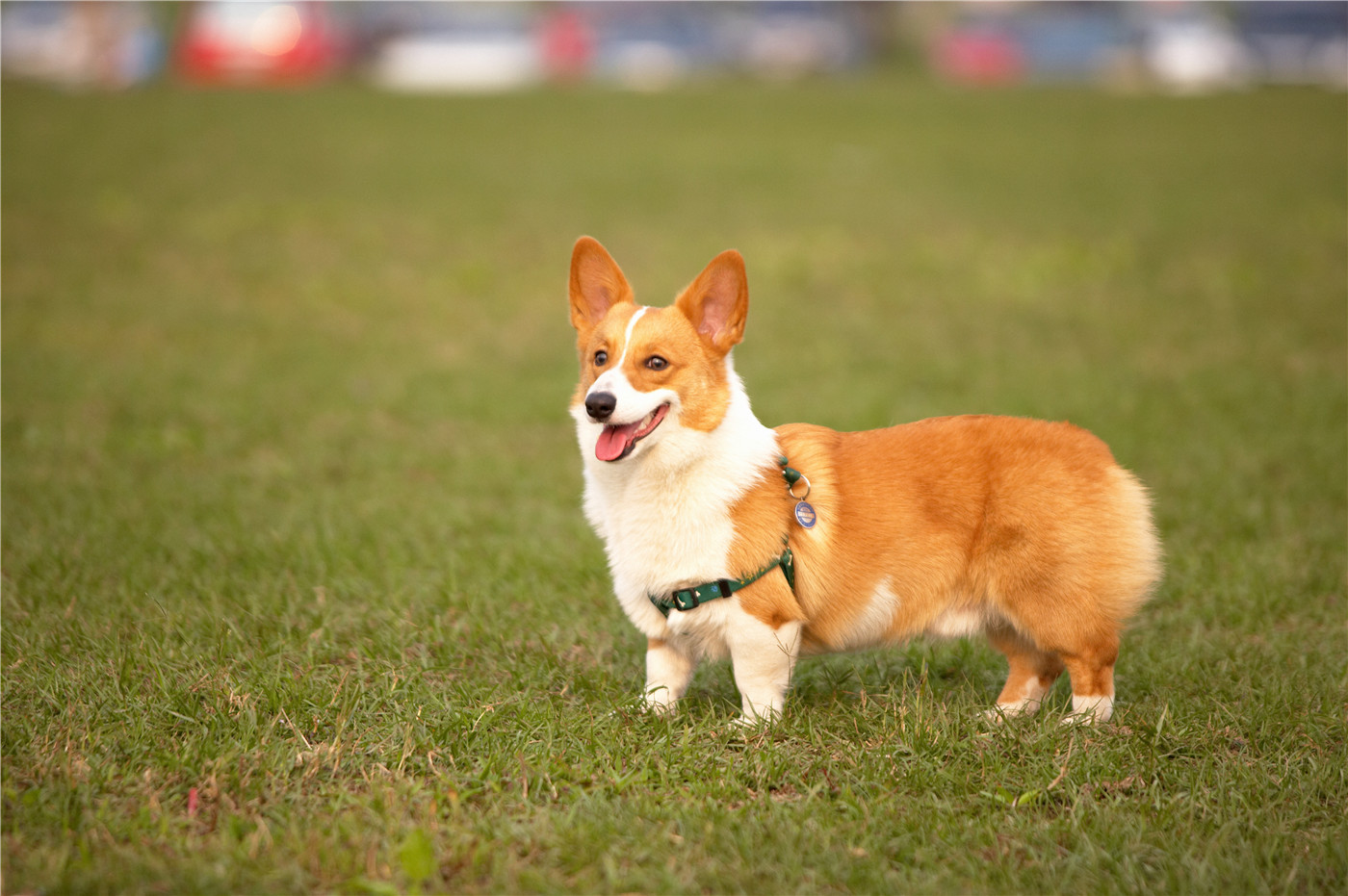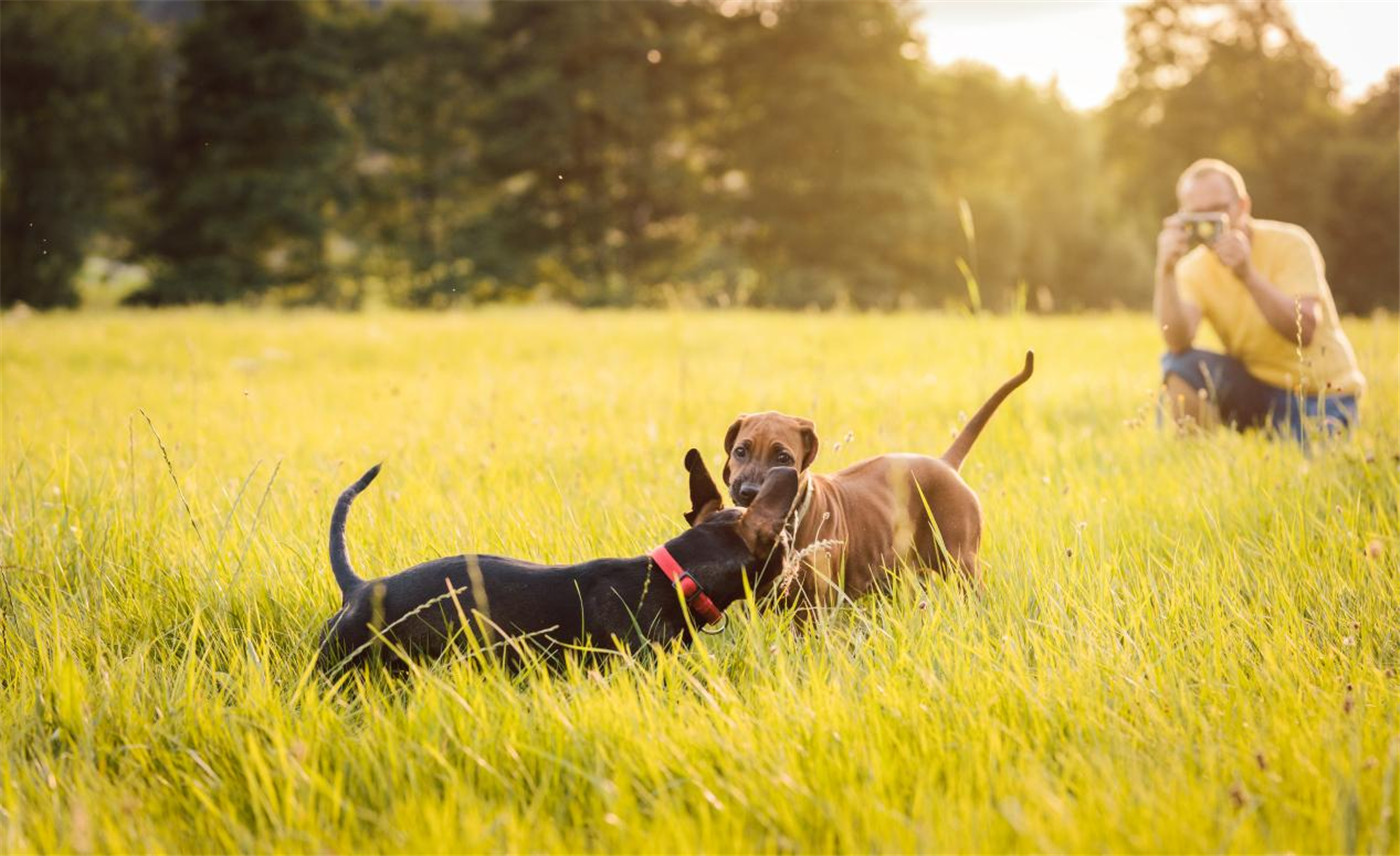Method 1
teach a dog to sit
1. Teaching a dog to sit is actually teaching it to switch from a standing state to a sitting state, that is, to sit down instead of simply sitting.
So first of all, you have to put the dog in a standing position. You can make it stand up by taking a few steps forward or back towards it.
2. Stand directly in front of the dog and let it focus on you.
Then show the dog the food you prepared for it.
3. Attract its attention with food first.
Hold the food with one hand and hold it up to the dog's nose so it can smell it. Then lift it over its head.
When you hold the treat over its head, most dogs will sit down next to your hand to get a better view of what you're holding.
4. Once you find that it has sat down, you should say "sit well", and praise it in time, and then reward it.
If there is a clicker, press the clicker first, then praise and reward it. The dog's reaction may be slow at first, but it will become faster and faster after repeated several times.
Be sure to wait until the dog is fully seated before praising it. If you praise him before he sits down, he may think you just want him to squat.
Don't praise it when it stands up, or the last one taught to sit down will be taught to stand up.
5. If you use food to make it sit down, it doesn't work.
You could try a dog leash. Start by standing side by side with your dog, facing the same direction. Then pull back on the leash slightly, forcing the dog to sit down.
If the dog still won't sit down, guide him to sit down by gently pressing down on the dog's hind legs while pulling back on the leash slightly.
Praise and reward him as soon as he sits down.
6. Don't keep repeating passwords.
If the dog doesn't respond within two seconds of the password being given, you'll have to use the leash to guide it through.
Every instruction is constantly reinforced. Otherwise the dog may ignore you. Instructions also become meaningless.
Praise the dog for completing the command, and praise for keeping it up.
7. If you find that the dog sits down naturally, praise it in time
Soon it will get your attention by sitting down instead of jumping and barking.

Method 2
teach a dog to lie down
1. First use food or toys to attract the dog's attention.
2. After successfully attracting the dog's attention, put the food or toy close to the ground and place it between its legs.
Its head will definitely follow your hand, and its body will naturally move.
3. When the dog gets down, praise it promptly and vigorously, and give it food or toys.
But be sure to wait until the dog is fully down, or it may misinterpret your intentions.
4. Once it can complete this action under induction, we have to remove the food or toys and use gestures to guide it.
Straighten your palms, palms down, parallel to the ground, and move from the front of your waist down to one side.
When the dog gradually adapts to your gestures, add the command "get down".
As soon as the dog's belly is on the ground, praise it immediately.
Dogs are very good at reading body language and can read your hand gestures very quickly.
5. When it has mastered the command "getting down", pause for a few seconds, let it maintain this posture for a period of time, and then praise and reward it.
If it jumps up to eat, never give it. Otherwise, what you reward is its last action before feeding.
If the dog does not stick to the completion of the action, just do it all over again from the beginning. As long as you persist, it will understand that what you want is for it to lie on the ground all the time.
6. When the dog has fully mastered the password.
You're about to start calling the shots standing up. Otherwise, the dog will only move in the end if you shout the password while gesturing. The training result you want should be that the dog will completely obey the password even if it is separated by a room.
Method 3
Teach your dog to wait by the door
1. Waiting at the door This point starts training early. You can't let the dog rush out as soon as the door is opened, it's dangerous. It is not necessary to train like this every time you pass through a door, but this training must start as soon as possible.
2. Tie the dog a shorter chain so that you can guide it to change direction in a shorter distance.
3. Lead the dog to the door.
4. Say "wait a minute" before stepping through the door. If the dog doesn't stop and follows you out the door, hold it with a chain.
Then try again.
5. When it finally understands that you want it to wait in the door instead of following you, be sure to praise and reward it.
6. Teach it to sit by the door.
If the door is closed, you'll have to teach it to sit while you hold the doorknob. Even if you open the door, sit and wait until you let it out. For the safety of the dog, it must be on a leash at the beginning of training.
7. In addition to waiting for this password, you also need to call it a password to enter the door.
For example, "Go in" or "Okay" and so on. As long as you say the password, the dog can go through the door.
8. When it learns to wait, you have to add a little difficulty to it.
For example, let it stand in front of the door, and you turn around and do other things, such as picking up the package, taking out the trash, and so on. You must not only let it learn to listen to the password to find you, but also let it learn to wait for you.

Method 4
Teaching Dogs Good Eating Habits
1. Don't feed it when you are eating, otherwise it will develop a bad habit of begging for food.
Let it stay in the nest or cage while you are eating, without crying or fussing.
You can prepare its food after you have finished eating.
2. Let him wait patiently while you prepare his food.
It can be annoying if it's loud and noisy, so try the "wait" command you've been trained to have it wait outside the kitchen door.
When the food is ready, let it sit and wait quietly for you to put things in front of it.
After putting something in front of it, you can't let it eat immediately, you have to wait for you to issue a password. You can come up with a password yourself, like "start" or something.
Eventually your dog will sit down when he sees his bowl.
Method 5
Teaching Dogs to Hold and Release
1. The purpose of "holding" is to teach the dog to hold anything you want it to hold with its mouth.
2. Give the dog a toy and say "take it".
Once he has the toy in his mouth, praise him and let him play with the toy.
3. It is easy to succeed in inducing the dog to learn to "hold" with interesting things.
When it really understands the meaning of the password, continue training with more boring things, such as newspapers, lighter bags, or whatever else you want it to carry.
4. While learning to hold, you must also learn to let go.
Say "let go" to him and let him spit the toy out of his mouth. Praise and reward him when he spits out the toy to you. Then continue with the practice of "holding". In this way, it will not feel that after "letting go", there will be no fun.
Don't compete with dogs for toys. The harder you tug, the tighter it bites.
Method 6
teach a dog to stand up
1. The reason for teaching a dog to sit or wait is easy to understand, but you may not understand why you should teach your dog to stand up.
You don't use the "stand up" command every day, but your dog will use it throughout his life. Think about how important it is for a dog to stand upright when it is being treated or groomed in a pet hospital.
2. Prepare a toy that the dog likes, or a handful of food.
This is not only a tool to induce it to learn, but also a reward for learning success. Learning to stand up requires the cooperation of "getting down". This way it will get up off the ground in order to get a toy or food.
3. You need to use toys or food to induce it to complete this action, so you first need to put something in front of its nose to attract its attention.
If it sits obediently, it wants to be rewarded. Bring the thing down a bit to get its attention back.
4. Let the dog follow your hand.
Open your palms, palms down, and if you have a toy or food, hold it in your hand. Put your hand in front of the dog's nose and slowly remove it. The dog will naturally follow your hand and stand up.
At first, your other hand can lift its hips and guide it to stand up.
5. When it stands up, praise and reward it in time. Although you didn't use the password "stand well" at this time, you can still say "stand well".
6. At first, you may only be able to use the bait to guide the dog to stand up.
But when it slowly stands up consciously, you have to add the "stand up" command.
7. After learning to "stand well", you can practice with other instructions.
For example, after it stands up, say "wait" or "don't move" to keep it standing for a while. You can also add "sit down" or "get down" and keep practicing. Slowly increase the distance between you and the dog. In the end, you can even give commands to the dog from across the room.
Method 7
teach a dog to talk
1. Teaching a dog to talk is actually asking it to bark according to your password.
There may not be many cases where this password is used alone, but if it is used together with "Quiet", it can solve the problem of dogs barking very well.
Be very careful when teaching your dog to talk. This password can easily get out of control. Your dog may bark at you all day.
2. The dog's password must be rewarded in time.
Rewards are even faster than other passwords. Therefore, it is necessary to use clickers with rewards.
Continue to use clickers until the dog sees the clickers as a reward. Use material rewards after the clicker.
3. Observe carefully when the dog barks the most.
Different dogs are different. Some may be when you have food in your hand, some may be when someone knocks on the door, some may be when the doorbell is rung, and still others are when someone honks the horn.
4. After discovering when the dog barks the most, make good use of this and deliberately tease it to bark.
Then praise and reward it.
But it is conceivable that an inexperienced dog trainer may teach the dog badly.
This is why dog talking training is a little different from other password training. Passwords should be added from the beginning of training. This way the dog will understand that you are praising him for obeying your command, not his natural barking.
5. When training for the first time to speak, the password "call" must be added.
When you hear it bark for the first time during training, say "bark" immediately, press the clicker, and then praise and reward it.
For other passwords, the actions are taught first, and then the passwords are added.
Then speaking training can easily get out of hand. Because the dog thinks that barking will be rewarded.
Therefore, speaking training must be accompanied by passwords. It is absolutely impossible not to say the password, just reward its barking.
6. Teach it to "bark" and teach it to be "quiet".
If your dog barks all the time, teaching him to "bark" certainly doesn't help, but teaching him to "be quiet" makes a big difference.
After the dog has mastered the "bark" it is time to teach "quiet".
First issue the "call" command.
But don't reward the dog after it barks, but wait for it to quiet down.
When the dog is quiet, say "quiet."
If the dog remains quiet, there is no more barking. Just hit the clicker and reward it.

Method 8
crate training
1. You may think that keeping your dog in a crate for hours is cruel.
But dogs are inherently burrowing animals. So dog crates are less depressing for them than they are for us. And, in fact, dogs who are used to living in crates will use the crate as their safe haven.
Closing the kennel can help restrain your dog's behavior in your absence.
There are many dog owners who keep their dogs in cages when they are sleeping or going out.
2. Although adult dogs can also be cage trained, it is best to start with puppies.
Of course, if your puppy is a giant dog, use a large cage for training.
Dogs will not defecate in sleeping or resting places, so the dog cage should not be too large.
If the dog's crate is too big, the dog may pee in the furthest corner because it has a lot of room.
3. Make the cage a safe haven for dogs.
Do not lock your dog in a crate alone for the first time. You want the crate to make a good impression on your dog.
Putting the crate in a crowded part of your home will make your dog feel like the crate is part of the home, not a secluded place.
Put a soft blanket and some favorite toys in the crate.
4. After dressing up the cage, you have to start encouraging the dog to enter the cage.
At first, put some food at the door of the cage to guide it. Then put the food in the door of the dog cage so that it will stick its head into the cage. After it gradually adapts to the cage, put the food into the depths of the cage bit by bit.
Lure the dog into the cage repeatedly with food until it goes in without hesitation.
Be sure to be very happy to praise your dog when crate training.
5. When the dog is used to being in the cage, feed it directly in the cage, so that the dog will have a better impression of the cage.
Put your dog's food bowl in the crate, and if he's still showing signs of agitation, put the dog bowl by the cage door.
When it gradually gets used to eating by the crate, put the bowl in the crate.
6. After a long period of training, the dog will become more and more accustomed to the cage.
At this time, you can try to close the dog cage door. But it still takes time to get used to.
Close the dog door when the dog is eating, because at this time, it will concentrate on eating and it will not be easy to notice you.
Close the dog door for a short period of time, and gradually increase the time for closing the door as the dog gradually adapts to the crate.
7. Never reward a dog for howling.
A small puppy may be endearing when it snorts, but a big dog's yelling can be annoying. If your dog keeps whining, it's probably because you've kept him shut for too long. But be sure to wait until it stops whining before releasing it. Because you have to remember that you rewarded it's last behavior forever.
Remember, don't let your dog go until it stops whining.
Next time you keep him in a cage, don't keep him in it for so long. #If the dog has been locked in the cage for a long time, comfort it in a timely manner. If your dog cries, take the crate to your bedroom at bedtime. Help your dog fall asleep with a Didi Alarm or a white noise machine. But before putting in the cage, make sure the dog has emptied and defecated.
Keep the pup's crate in your bedroom. That way you won't know when it needs to come out in the middle of the night.
Otherwise, it will be forced to defecate in the cage.
Post time: Nov-14-2023









